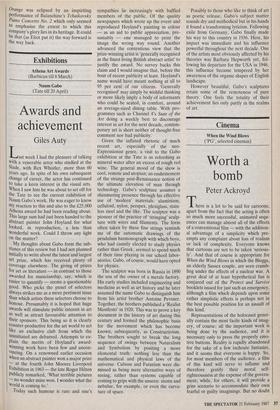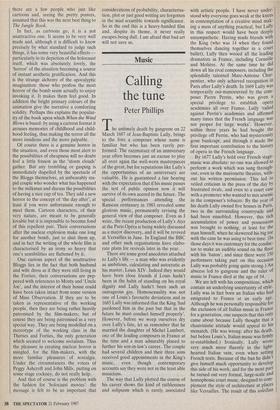Cinema
When the Wind Blows (PG', selected cinemas)
Worth a bomb
Peter Ackroyd
There is a lot to be said for cartoons; apart from the fact that the acting is often so much more successful, animated sequ- ences can manage almost all of the effects of a conventional film — with the addition- al advantage of a simplicity which pre- empts any complaint about loss of realism or lack of complexity. Everyone knows that cartoons are not to be taken 'serious- ly'. And that of course is appropriate for When the Wind Blows in which the Bloggs, an elderly Sussex couple, are seen crumb- ling under the effects of a nuclear war. A great deal of at least hypothetical fun is conjured out of the Protect and Survive booklets issued for just such an emergency, although a film which depends upon some rather simplistic effects is perhaps not in the best possible position for an assault of this kind.
Representations of the holocaust gener- ally contain the most facile kinds of imag- ery, of course; all the important work is being done by the audience, and it is necessary only to press the properly emo- tive buttons. Reality is rapidly abandoned for the sake of a few inchoate fantasies, and it seems that everyone is happy. So, for most members of the audience, a film of this kind will serve to inflame and therefore gratify their moral self- righteousness at the expense of the govern- ment; while, for others, it will provide a grim scenario to accommodate their own fearful or guilty imaginings. But no doubt there are a few people who just like cartoons and, seeing the pretty posters, assumed that this was the next best thing to The Jungle Book.
In fact, as cartoons go, it is a not unattractive one. It seems to be very well made and, although it is difficult to know precisely by what standard to judge such things, it has some very beautiful effects particularly in its depiction of the holocaust itself, which was absolutely lovely, the `horror' of the situation becoming a source of instant aesthetic gratification. And this is the strange alchemy of the apocalyptic imagination: those who profess the most horror of the bomb seem actually to enjoy invoking it. It makes them feel good. In addition the bright primary colours of the animation give the narrative a comforting solidity. Perhaps this explains the popular- ity of the book upon which When the Wind Blows is based: by using a cartoon format it arouses memories of childhood and child- hood feeling, thus making the terror all the more insidious and the more palpable.
Of course there is a genuine horror in the situation, and even those most alert to the possibilities of cheapness will no doubt feel a little frisson as the 'storm clouds' gather. But any trembling or gasping is immediately dispelled by the spectacle of the Bloggs themselves, an unbearably stu- pid couple who wonder what has happened to the milkman and discuss the possibilities of having a nice cup of tea. They add a new horror to the concept of 'the day after', at least if you were unfortunate enough to meet them. Cartoon characters, of their very nature, are meant to be generally lovable but it is impossible to become fond of this repellent pair. Their conversations after the nuclear explosion make one long for another bomb, just to shut them up, and in fact the writing of the whole film is characterised by an irony so heavy that one's sensibilities are flattened by it.
One curious aspect of the unattractive Bloggs lies in the fact that both husband and wife dress as if they were still living in the Forties; their conversations are pep- pered with references to Monty and 'Uncle Joe', and the interior of their house could have been taken intact from some version of Mass Observation. If they are to be taken as representative of the working people, then they are being rather heavily patronised by the film-makers; but of course they are being patronised in a very special way. They are being modelled on a stereotype of the working class in the Thirties and Forties, the only generation which seemed to welcome socialism. Thus the pleasure in creating nuclear horror is mingled, for the film-makers, with the more familiar pleasures of nostalgia. Under the circumstances the voices of Peggy Ashcroft and John Mills, putting on some stage cockney, do not really help.
And that of course is the problem with the fashion for 'holocaust movies': the message is felt to be so important that considerations of probability, characterisa- tion, plot or just good writing are forgotten in the mad scramble towards significance. So in the end this is a heavy-handed film and, despite its theme, it never really escapes being dull. I am afraid that bad art will not save us.



















































 Previous page
Previous page